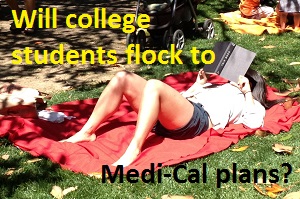California is facing the prospect of adding 1.4 million people1 to its Medi-Cal rolls because of the expanded eligibility for the Medicaid program under the Affordable Care Act. Children, individuals, and families will automatically be placed into a Medi-Cal HMO health plan category when they apply for health insurance through Covered California and their income is below certain federal poverty level guidelines.
No tax credits if Medi-Cal eligible
Once a person is deemed eligible for Medi-Cal, they are not eligible for premium assistance. If the individual or family wants discounted or no cost health insurance they must accept Medi-Cal. They always have the option of purchasing a private health plan through Covered California at full market price.
California Department of Managed Health Care Model Notice for insurers
Free or low-cost health insurance is available through Medi-Cal. Medi-Cal is California’s health care program for people with low incomes. You can get Medi-Cal if:
Your income is low; and
Your eligibility is based on your income. It is not based on how much money you have saved or if you own your own home. You do not have to be on public assistance to qualify for Medi-Cal. You can apply for Medi-Cal anytime.
You are a U.S. citizen, U.S. national or lawfully present in the U.S.
Will college students flood into Medi-Cal?
We can be fairly certain that the big push to enroll college students into new ACA health plans will result in a large portion of the students channeled into Medi-Cal plans. It is estimated that are 480,000 young adults age 19-29 that will be eligible for Medi-Cal2. If we assume a full-time student is able to work 20 hours per week, that monthly wage still puts them below the 138% of the federal poverty line ($15,865) and automatic Medi-Cal.
20 hours x $10.50 = $210.00 per week x 4 weeks = $840.00 x 12 months = $10,080.00 per year
It may be an allusion that young invincibles are necessary to make the ACA a success when so many will not be enrolled in private health insurance but state subsidized Medicaid programs. Nonetheless, Covered California and state universities will be making a concerted effort to get college students to sign up for the new health plans.
Medi-Cal is turning into big money maker
Of course, Medi-Cal is administered on the county level and many of the health plans are run by private companies. Many insurance companies see the expanded Medi-Cal enrollment program as a real money maker (see- Aetna finds profit opportunity in Medicaid under ACA and Wellpoint to acquire Medicaid administrator). Even if the monthly reimbursement might not be equal to market rate premiums, the government usually pays promptly relieving the company of chasing down people who don’t pay their monthly premiums in the individual market. The big fat icing on the cake is that young college kids aren’t sick and don’t get sick. So relative to the entire Medicaid population, insurance companies will make money from the young adult Medi-Cal members.
Medi-Cal has all the new ACA benefits
The good news is that all the Medi-Cal HMO plans will be equivalent to health plans through Covered California or outside the exchange. They will all include the 10 essential health benefits, preventive office visits at no charge, contraceptives and low or no copayments for most services. The downside is that the members will have to designate a primary care physician and only use the network of providers associated with the health plan.
A really tight provider network
Many of the networks will not be as large as health plans offered through Covered California carriers. Medi-Cal providers receive lower reimbursements for services than those negotiated by private health insurance companies. The reduced payment schedule, which is under pressure to be cut even more, has led many physicians to scale back the number of Medi-Cal members they see or exit the program as a provider all together. Consequently, wait times for office visits and services may grow longer as more low income California residents are funneled into Medi-Cal health plans.
Each county administers the Medi-Cal health plans through their Health and Human Services Department. The HMO plans bid to offer their health plans to the various counties. Some counties will have multiple plan to choose from while other counties will only have one plan
October Update
From all the news reports thousands college students who are not taken as a dependent on their parents taxes have successfully enrolled in a county based Medi-Cal HMO plan with no problems at all. However, I have heard reports that San Diego County has been very aggressive with college students trying to determine if they truly have an income below 138% of the Federal Poverty Line. Tactics include numerous letters demanding letter of income and parental assistance and phone calls to verify income. San Diego County even denied one woman Medi-Cal after Covered California determined she was eligible. I’d be interested in hearing if anyone else has been challenged by their county over their Medi-Cal eligibility.
Covered California Medi-Cal health plans by county
[gview file=”https://insuremekevin.com/wp-content/uploads/2013/11/medi_cal_health_plan_by_county_list.xlsx” save=”1″]
1,2 CalSIM version 1.8 Statewide Data Book 2014 – 2019, UCLA Center for Health Policy Research and UC Berkeley Labor Center.


